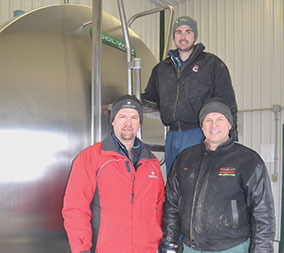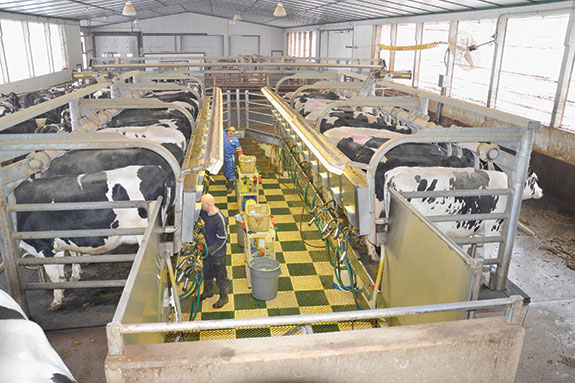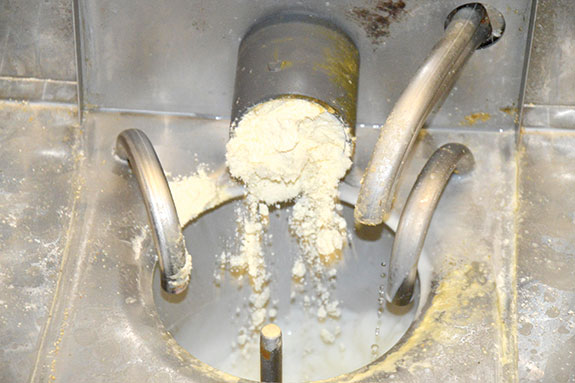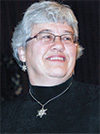The family owns 100 acres but rents an additional 1,400 acres on which they grow corn, wheat, soybeans and hay.

In the ’80s, the farm had an old bank barn, with tiestalls for 45 cows and an adjoining loafing shed. With 70 milking cows, this entailed changing groups at each milking. By 2000, they were milking 186 cows in the old facility.
It was very labour-intensive – two people handled six milking machines while one person was constantly moving cows.

The brothers chose to embrace new technology but decided to expand gradually so as not to go deeply into debt. “Everything here has been generated out of farming,” Philip declares. They increased their quota every year and are still adding as it becomes available.
In 2001, they erected a freestall barn for 240 cows, with a double-12 parallel parlour and a special-needs area.
In 2006, they built a cover-all heifer barn, for animals from 3 months old until pregnancy-checked in calf.
This barn accommodates about 140 heifers, grouped according to age.
In 2007, they added a robotic calf feeder to their calf barn.
There are four pens with about 10 calves per pen. Calves are identified shortly after birth with RFID chips in the ear.

They are started on the robotic calf feeder at 3 days old, receiving 150 grams of milk replacer per one litre of water.
They are allowed up to a maximum of three litres per feeding, to a 12-litre maximum per day, and always have access to water and calf starter. At 35 days old, the mix starts to decline until, at 52 days, they are fully weaned with no stress and no bawling.
They are moved to a transition barn for approximately six weeks, and then on to the heifer barn.
The Armstrongs say they save two man-hours each day by handling calves in this manner, compared to the hutches they had previously used, and that their calves are doing better.
Heifers are bred at 12 months old, all by A.I. with the use of sexed semen, which gives them a 90 percent chance of having a female calf.
They have found that their conception rate is higher on heifers than cows, so the price difference is worth the investment. Other benefits include easier calving, as heifer calves tend to be a bit smaller, and a speeding up of genetic improvement with the theory being that heifers should be better than their dams.
The Armstrongs take nasal swabs on their calves and submit them to Holstein Canada with the registration application.
Results, including the Lifetime Production Index (LPI), production and conformation traits, are posted with the Canadian Dairy Network and available for anyone to see. Philip states, “(This is a) good tool for us on this farm. It’s a good fit for us.”
They choose their replacement heifers based on this genomic information. They keep about two-thirds of the heifers born and sell the remainder at 9 to 12 months, not bred.
These are sold as recipient heifers for embryo transfer purposes. The Armstrong herd has been tested and is free of enzootic bovine leukosis. Therefore, buyers know they are not bringing home a problem from this closed herd.
All cows are registered Holsteins, but this is essentially a commercial, rather than a show herd. The Armstrongs’ goal is to improve type; at this point 60 percent of the herd is classified GP or better. They have one EX and are aiming for more.
The herd now numbers about 260 milking cows. In 2008, they switched to 3X milking. Cows are fed a total mixed ration (TMR) twice a day, using a mixer wagon along the drive-through feeders.
The TMR is made up of corn silage, corn gluten, cracked corn, dry hay and a purchased protein supplement. The cows lounge on mattresses with sawdust bedding for comfort, and scrapers clear the alleys at two-hour intervals.
The milking herd is divided into four groups; a first-calf heifer group, a fresh group, an early-lactation group and a late-lactation group.
Dry cows and in-calf heifers are housed in the old barns, with adjoining outdoor yards.
Until a couple of years ago, the brothers used ID activity chips on the cows’ necks but did not find them to be very accurate in pinpointing heats. They have changed to a pedometer (ankle strap with chip) for identification, heat and activity detection.
They are easier, cheaper and they find that their pregnancy rate has improved. “Lot more accurate – we can breed on that,” Peter states. They have had no problem with cows losing the straps.
Feeding is Peter’s responsibility in the morning and is carried out by an employee in the afternoon. Philip and Richard are in charge of dry cow care and are on duty for overnight calvings. Richard fills in if employees are absent due to illness or holiday. All three share the workload of the cropping season.
The brothers agree that their employees contribute a great deal to the operation. “Good reliable workers ... that’s what makes this a success ... their dedication,” Peter states.
They employ three full-time workers, all of whom have been with them for seven years or more. These people are responsible for the dairy operation – milking, breeding, everything, leaving the brothers free to handle management, “joe jobs,” field work, maintenance and repairs, and machinery work. In addition to the full-time workers, five part-time people come in for milking only.
The Armstrong men are involved in off-farm activities too. Philip is a director with the local Federation of Agriculture, and in his spare time, is an avid reader. He says he reads everything, but mentioned particularly history, science fiction and fantasy genres.
He also enjoys cycling. Peter is on the board of the Progressive Dairy Operators and enjoys a game of golf for his leisure.
Richard is involved with sports, playing hockey and soccer, and is a director of the local Soil and Crop Improvement Association. They are also involved in their church.
Philip is scheduled as a speaker at the upcoming Triennial Dairy Symposium, hosted by the Progressive Dairy Operators, to be held March 25-27 in Toronto. He will be speaking on the use of genome technology in their operation. PD
Alice Guthrie is a freelance writer from Hagersville, Ontario.
PHOTOS
TOP: Brothers Peter (left) and Philip (right) Armstrong, with Philip’s son Richard (above), are the fifth and sixth generation on their Caledon, Ontario, farm.
MIDDLE: Employees milk 260 cows, three times a day, in a double-12 parlour.
BOTTOM: Milk replacer is automatically mixed in a robotic calf feeder. The Armstrongs estimate this saves them two man-hours a day. Photos courtesy of Alice Guthrie.








